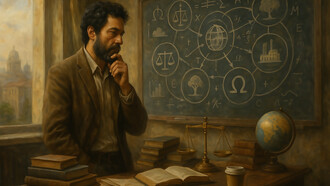For Italians, the “piazza”, the square, is not just the architectural space that characterizes cities and villages but an open air, urban living room, utmost expression of Italy’s identity. It is the pivot of each Italian town where history, architecture, and social relations become one. The piazza means belonging to a society and it means daily life.
In each town, the piazza reunites the two most important buildings: usually city hall and the cathedral, the religious power and the political power face each other and between them people carry on their daily life, new acquaintances and friendships are made, economic agreements are reached. The piazza is like an interval among words, an empty space which is necessary to appreciate the main buildings, just like spaces between words are necessary to read a phrase.
The piazza, differently from all other places, is a space which is not only constituted by architectural arrangements but, more than any other, it comes to life thanks to the people who fill it with meaning. Ask any Italian migrant what he misses, he/she will answer “the piazza”.
The piazza has a meaning that goes well beyond the description one will find on a dictionary. The piazza means that even the most lonely person can find someone to talk with. It means that, without spending a single cent in a restaurant or a movie theatre, he/she can have hours of social life, can feel a sense of belonging, can learn about births, deaths, marriages and can finally go home without that terrible feeling of estrangement which is typical of other cultures.
On the Italian piazza, there is also usually a café, the most important “bar”, as it is called in Italian, the place to see and be seen, where older people will sit down for hours at a table sipping an espresso and reading a newspaper while, from time to time, lifting the eyes to gaze at new generations passing by, the girls dressed up for the Sunday stroll and the boys straight out of the barber shop with gel sleek hair.
The piazza is also the starting and ending point of Sunday “laps” on the “Corso”, the main street of the town, where especially young people walk back and forth, where shy teenager girls blush feeling the gaze of young boys who use the same space to display their budding manhood.
The piazza has its own rituals where people are the actors who make the piazza come alive. Often the “circolo”, the city club house where older men go play cards or chat, also faces the main piazza together with the newspaper stand, the bank, and the house of the town most prominent family.
The piazza is alive the entire day, it seems to empty at dinner time just to explode after dinner, after having retired to the intimacy of family, the balance is reached by returning to the social dimension of community life.
The piazza also has such a strong political meaning that it is used as a metaphor to describe the involvement in a political protest. “Scendere in piazza”, literally “going down on the square”, means the coming together of people to protest, thus the use of the term piazza in this situation strongly signifies the union of the people of a society, of a town.
The square contributes to preserve the memory of the past as well as of a lifestyle which is continuously threatened by the characteristics of the society of today. While we powerlessly observe a progressive isolationism of young people hiding behind a computer screen, at the same time in Italy we see young people flooding the squares to socialize just as it happened centuries ago. It is this sense of community and belonging which immigrants miss above all in the American society. In the USA, the piazza does not exist as it does in Italy leaving the immigrants from the Bel Paese with a sense of emptiness that is impossible to fill.
The Italian piazza, whose name is very similar to the Greek plateia and the Roman platea, both meaning wide space, draws its origin from the Greek agora and the Roman forum. In Greece, the agora was the center of the religious and commercial power but, above all, it was the symbol of democracy so much so that the Assembly gathered there to discuss political issues. In Rome, the forum, played a similar role but, additionally, it was also a monument to Roman civilization and so the Latin culture was visible even in the remotest corners of the Roman empire. This is the origin of the concept of “ideal city” that was supposed to respect and display the imago Urbis, the city image, of Rome. According to this criterium, each city had to have the typical structures of the Roman world: the Spa, the amphitheatre, the basilica, the temple and the forum. Just like in the Hellenic culture, the main square was the pivot around which revolved the life of the community but it was also its symbol and thus had to be majestic with a portico connecting it to the temple. The forum consequently became also the geometric centre of the city, located at the crossing of the cardo and the decumanus, the city main streets.
During the Middle Ages, the square lost its hierarchical power over the other buildings. It was a very belligerent time with few political certainties, so the cities were more compact and developed around fortified centers. The building of the city cathedral, or the castle, or the city hall brought about a square, which became a consequence of the first. Squares were actually considered dangerous places at that time because they could allow the gathering of people and thus their rebellion and possible attacks.
After the year 1000, the squares started to be differentiated depending on whether they had a religious, political or commercial role. In Siena and Padua, for example, the cathedral square, the public buildings square, and the market square are in three distinct locations. In Modena, the cathedral is at the gravity centre of the ancient urban centre and it has determined the complex of the nearby interconnected squares. In Florence, piazza della Signoria, where city hall is, has been created after the demolition of houses and towers and it is totally separated from the Old Market square and the Cathedral square.
During the Renaissance, the constitution of the square is determined by the use of the concept of perspective and the square is seen as the theatre where the actors are the people who live in the city. Until a few decades ago, the Italian piazza maintained its central role in the town and also its function. In the last decades of the 19th century, political choices were often made to close the squares to car circulation. This choice has not always been successful and many squares, like Piazza San Silvestro in Rome, lost their role and their life. Probably, music is helping many squares keep their old role.
Painters have portrayed the piazza. The first that comes to mind is The Ideal City, a 15th century painting of unknown author, symbol of the Renaissance. At more or less the same time, Gentile Bellini paints a real piazza, Saint Mark in Venice. Portraying a real event, this is a 7 meter wide canvas crowded with people and, although perspective is not perfect, it egregiously renders the concept of harmony. In more recent times, surrealist Giorgio De Chirico has interpreted the piazza in a game of bright lights and deep shadows.
The piazza is also celebrated in literature. Giacomo Leopardi, in his 1829 poem Il sabato del Villaggio (Saturday in the village), describes the arrival of a young girl to the village square on a Saturday afternoon; Umberto Saba in Piazza del Duomo evokes the sense of community: “[…] Every evening, instead of stars, words light up”. In the 20th century, architect Giuseppe Samonà defines the piazza as the “stone archive” of the city, a place of transformation and memory.
It is on the main square of the town that often concerts take place thus pushing people to reunite as it happened “normally” until a few decades ago. It is to the piazza that Italian songwriters have dedicated songs like Piazza Grande, by Lucio Dalla, referring to the city of Bologna, which becomes the symbol of all cities, and Piazza del Popolo, by Claudio Baglioni, dedicated to the Roman square with the same name, where he refers to the gathering of young people on the square who sang “and became one”.
Today, the real square has a challenger: the virtual piazza. Unlimited by architectural boundaries, this piazza, as writer Giuseppe Fumarola states, “is a reality of appearances but not an apparent reality. The telematic piazza has its own conceptualized reality because situations are constructed in a symbolic manner but this does not mean that they do not give way to concrete deeds”. Telematic squares are however very distant from the concept of piazza as we know it and which is peculiar to Italy. It is the difference between virtual and real.
If the virtual piazza is almost universal (many countries still limited or nonexistent internet access), the Italian, real piazza is peculiar to Italy, which shows that the piazza is not just an architectural concept but a historical, social, and cultural concept.














